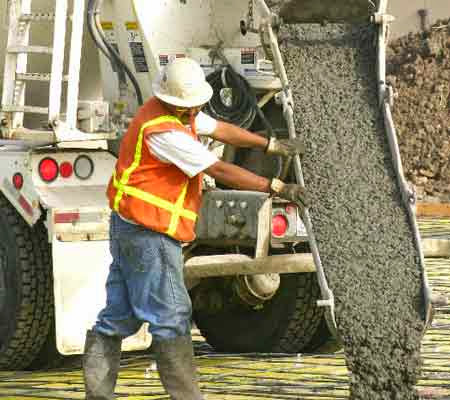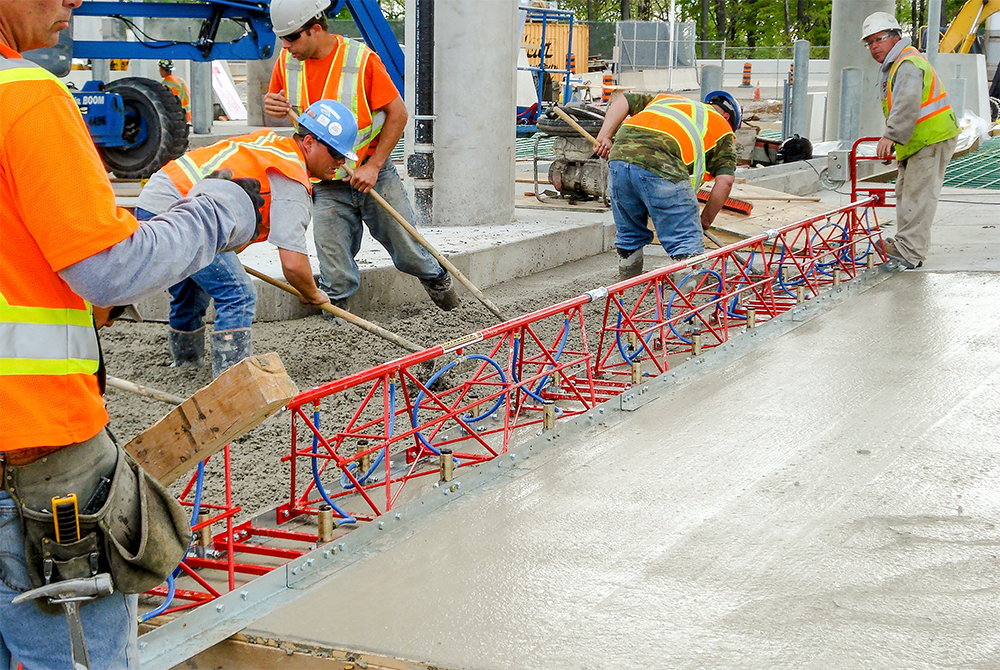The Important Function of Concrete Structure in Structural Stability and Longevity
When it involves developing a home, the structure is a lot more essential than you might assume. Concrete foundations supply unparalleled toughness and longevity, ensuring your framework can hold up against numerous ecological challenges. Without a strong base, you risk potential problems like moving or cracking, which can compromise safety and security and value. Comprehending the subtleties of concrete structures can be the key to protecting your financial investment for several years ahead. What should you take into consideration following?
Understanding the Value of Concrete Foundations
Concrete structures are essential to the overall security of any kind of structure, as they give the crucial assistance required to endure various lots and ecological problems. When you think of constructing a home or an industrial area, the structure is the very first point you ought to think about. It functions as a barrier versus dampness, shielding your building from water damage. A well-placed concrete foundation additionally stops settling and moving, which can cause splits in wall surfaces and floors. You'll want to ensure that the structure is properly made and enhanced, as this impacts the durability of your building. Additionally, a solid structure can improve energy effectiveness by minimizing air leaks. Keep in mind, ignoring the significance of a concrete foundation can bring about expensive repairs down the line. Investing in a high quality foundation upfront is vital for the stability and durability of your framework.
Advantages of Concrete Structures for Architectural Stability
While many factors add to a building's architectural integrity, concrete structures provide unmatched sturdiness and stamina. You'll value that concrete can withstand severe climate problems, standing up to both wetness and temperature changes. This durability indicates your structure is less most likely to experience cracking or moving with time, which can compromise its safety.Additionally, concrete's inherent weight supplies a solid base, protecting against activity during natural occasions like quakes or floods. When you choose a concrete foundation, you're also opting for low upkeep; unlike timber, it won't rot or bring in parasites, conserving you time and money in repairs.Moreover, concrete's fire resistance provides included safety, ensuring your framework can withstand heats without substantial damages. Generally, spending in a concrete foundation suggests you're focusing on the lasting stability and integrity of your structure, making it a sensible selection for any building project.
Common Types of Concrete Foundations
When it involves developing foundations, understanding the typical types of concrete structures can assist you make informed choices for your project. The most prevalent types include slab-on-grade, crawl space, and complete cellar foundations.A slab-on-grade structure is a basic, cost-efficient alternative, where a thick concrete piece is put directly on the ground. This type works well in cozy climates, as it lessens warmth loss.Crawl room structures raise the home slightly above ground, enabling ventilation and access to pipes and electric systems. This style can assist stop dampness issues.Full basement foundations provide additional living or storage room while supplying superb architectural support. They need more excavation and are typically made use of in cooler environments to prevent frost heave.
Aspects to Take Into Consideration When Designing a Concrete Foundation

Best Practices for Setting Up Concrete Foundations
When you're mounting a concrete structure, proper website preparation is vital to ensure security (West Coast General Engineering industrial concrete Rancho Cucamonga). You'll additionally need to comprehend support strategies to boost toughness and toughness. Don't ignore the treating process, as it plays a fundamental duty in accomplishing a strong structure.
Website Prep Work Relevance
It may appear simple, appropriate website preparation is important for guaranteeing a strong and resilient concrete foundation. Beginning by getting rid of the area of any particles, plant life, or organic product that can endanger the foundation's honesty. Next off, evaluate the dirt kind and compaction; you might need to excavate or add materials to create a steady base. Level the ground to guarantee even weight circulation and stay clear of clearing up concerns later. Mounting correct drain systems is additionally necessary to avoid water build-up, which can deteriorate the foundation in time. Lastly, mark out the structure's dimensions accurately to guide the pouring process. By complying with these steps, you'll establish the phase for an effective concrete foundation that stands the examination of time.
Reinforcement Techniques Explained
As soon as the site is correctly prepared, the following step in ensuring a sturdy concrete structure includes carrying out reliable support strategies. You should begin by utilizing steel rebar, which provides tensile toughness and assists avoid cracking. Lay the rebar in a grid pattern, ensuring it rises utilizing spacers to preserve proper protection. Additionally, take into consideration using cord mesh for added assistance, particularly in areas based on hefty tons. Don't neglect to connect the rebar junctions securely with cable. For larger structures, fiber reinforcement can boost toughness, lowering the danger of contraction cracks. Constantly adhere to local building ordinance and guidelines to ensure conformity. By applying these support strategies, you'll considerably enhance your structure's strength and durability, laying a solid foundation for your structure.
Healing Process Essentials
To assure your concrete structure cures effectively, it's important to preserve appropriate moisture and temperature level problems immediately after putting. Start by covering the surface with a damp burlap or plastic bed linen to maintain dampness. This keeps the concrete moisturized, preventing splits and ensuring strength. You need to likewise keep an eye on the temperature level; ideal healing problems are between 50 ° F and 90 ° F. If it's also warm, cobble concrete stamp haze the surface area consistently to stop fast dissipation. For cold climate, think about utilizing shielding coverings to keep heat. Go for a curing period of at least 7 days, as this is crucial for optimal toughness growth. By following these ideal methods, you'll enhance your foundation's toughness and longevity, guaranteeing see this site architectural honesty for many years to find.
Upkeep of Concrete Structures for Long Life
To keep your concrete structure solid and long-term, routine examinations are necessary. You should additionally assure reliable drainage services remain in place to avoid water damage. If you identify any type of fractures, addressing them quickly will save you from bigger troubles down the line.

Routine Inspections and Evaluations
While normal inspections and assessments might seem like a task, they're important for preserving the integrity of your concrete foundation. By regularly inspecting for fractures, changes, or signs of wear, you can catch prospective issues prior to they rise into pricey repair work. Try to find any kind of water merging around the foundation or unusual settling, as these can signify underlying troubles. It's additionally a good idea to keep track of any kind of adjustments in your home's structure, like doors that stick or windows that do not open efficiently. Maintaining a record of your inspections assists track modifications gradually, enabling proactive upkeep. Ultimately, these analyses ensure your structure continues to be secure, sustaining the durability and security of your whole framework. Do not forget this essential facet of homeownership!
Efficient Drainage Solutions
Routine inspections can reveal concerns like drain troubles that may jeopardize your concrete foundation's stability. To avoid water buildup, guarantee your seamless gutters and downspouts straight water away from the structure. Installing French drains can efficiently redirect surface and groundwater, lowering stress on your foundation wall surfaces. Furthermore, rating the dirt around your home assists assure that water moves away, as opposed to pooling near your foundation.Consider utilizing sump pumps in locations prone to flooding, as they proactively remove excess water. Routinely look for obstructions in water drainage systems and clear them promptly. You'll shield your structure's honesty and durability by taking these proactive procedures. Bear in mind, reliable drainage solutions are crucial for preserving a solid, resilient concrete foundation.
Prompt Split Services
When you discover splits in your concrete structure, addressing them promptly is necessary for keeping its long life. Tiny fractures can rapidly progress into bigger issues, jeopardizing the structural stability of your home. Routinely examine your structure for indicators of damages, such as horizontal or upright cracks. If you spot any, do not wait-- look at this website fix them instantly. You can make use of epoxy shots or concrete patching compounds, which are efficient for securing fractures. Always adhere to the supplier's guidelines and think about getting in touch with an expert for substantial damages. Keep in mind, prompt repair services not just improve your structure's longevity but likewise save you cash over time by protecting against extra substantial fixings down the line. Keep aggressive, and your foundation will continue to be strong and protected.
Resolving Typical Problems With Concrete Structures
Concrete foundations can encounter various issues over time, making it vital to identify and address them promptly. One of one of the most common issues is cracking, which can happen as a result of temperature level fluctuations or resolving soil. If you discover cracks, it's important to assess their dimension and deepness; tiny fractures can usually be secured, while bigger ones may require expert evaluation.Water invasion is one more major concern. Excess moisture can result in mold growth and architectural damage. Warranty correct drainage around your structure to minimize this danger. In addition, search for indications of shifting or bowing walls, as this can suggest underlying problems with your foundation's stability.Regular inspections are fundamental to catch these issues early. If you find any type of concerning signs, do not be reluctant to speak with a structure professional. By staying aggressive, you can keep the stability and long life of your concrete foundation, guaranteeing your home stays risk-free and protected.
Frequently Asked Concerns
How Does Dirt Type Affect Concrete Structure Efficiency?
Soil kind significantly impacts concrete structure efficiency. If you've obtained expansive clay, for example, it can trigger shifting and fracturing. Sandy dirt may bring about clearing up. Comprehending your soil helps guarantee a secure foundation.
Can Concrete Foundations Be Fixed if Harmed?
Yes, you can repair damaged concrete foundations. Relying on the level of the damage, techniques like epoxy shot or slab jacking can restore security. It's finest to get in touch with an expert for reliable remedies.
What Is the Common Life-span of a Concrete Foundation?
A concrete structure typically lasts 30 to 100 years, relying on variables like dirt problems, climate, and maintenance. You'll want to watch on it to assure it continues to be healthy throughout its life expectancy.
Are There Option Products to Concrete for Foundations?
Yes, there are alternatives to concrete for structures, like steel, hardwood, or perhaps recycled products. Each option has one-of-a-kind advantages and drawbacks, so you ought to consider your project's particular requirements when picking the appropriate material.
Exactly How Does Environment Impact Concrete Structure Longevity?
Environment considerably influences concrete structure durability (West Coast General Engineering industrial concrete Rancho Cucamonga). Extreme temperatures, wetness, and freeze-thaw cycles can deteriorate the product, bring about splits and architectural concerns. You need to take into consideration local environment conditions when planning your foundation to guarantee lasting efficiency